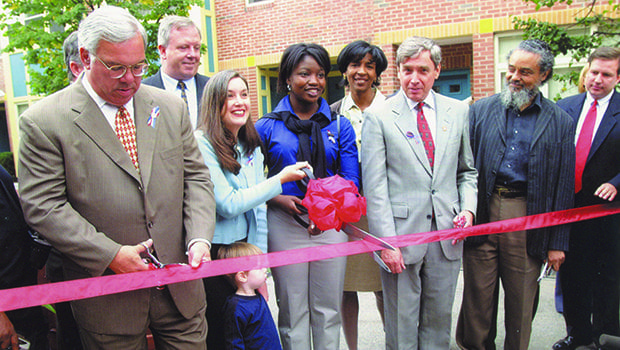

Author: Banner file photoMenino reviews a model of sculptor Fern Cunningham’s Harriet Tubman monument, soon to be installed in the South End.
When he was on the campaign trail back in 1993, then-acting Mayor Thomas Menino made a promise that caught the attention of many in the black community. Menino said he would focus city resources on rebuilding Blue Hill Avenue, then a major thoroughfare strewn with vacant lots and abandoned buildings.
That promise may have been a major factor in Menino’s lock on the black vote in that 1993 election. And his steady progress on the corridor from Grove Hall to Dudley Street won him many supporters in the following years. It also served as a blueprint for the Menino administration’s focus on neighborhood development.
The mayoral administrations that preceded Menino’s — Ray Flynn, Kevin White, John Collins — focused on downtown development, while outlying areas like Roxbury suffered through Urban Renewal land clearances followed by decades of neglect.
On the section of Blue Hill Avenue between Grove Hall and Dudley Street, the years of disinvestment were showing. Once elected, Menino rolled up his sleeves and got to work.
“He kept his word,” said Project RIGHT Executive Director Jorge Martinez. “We still have a lot of work to do, but he brought in a whole lot of city resources.”
The Grove Hall Mecca Mall, a new library and an early education center sprang up on Blue Hill Avenue, along with new housing units and commercial spaces.

Menino was ubiquitous at community events.
Nowhere was the Menino administration’s focus on neighborhood redevelopment more evident than in Dudley Square, where the redevelopment of the Ferdinand Building as the new headquarters for the school department redefined the Roxbury skyline. That project preserved the limestone and brick facades of the Ferdinand and several adjacent buildings while a new brick and granite-faced structure was built linking the historic buildings.
The ground floor commercial spaces and the influx of hundreds of city workers are expected to add new vitality to Roxbury’s commercial hub when the building opens in 2015.
Other large buildings, including the former Roxbury Boys Club, Palladio Hall and the Dartmouth Hotel were redeveloped with significant public investment.
Menino’s development plans for Roxbury weren’t always met with enthusiasm. Things got off to a rocky start in the mid-1990s when several development projects in Lower Roxbury were greenlighted by City Hall with little or no community review, including the Harry Miller manufacturing plant on Melnea Cass Boulevard.
Things came to a head in 1998, when the Menino administration backed the proposed construction of a Northeastern University student housing building on Tremont Street in Lower Roxbury over the vociferous opposition of community groups and local black elected officials. The project was to be built on publicly-owned land the city acquired and cleared in the early ’70s with funding from the federal Department of Housing and Urban Development.

Menino cuts the ribbon at the renovated Emerson School yard on Dudley Street. Among those looking on are then-DSNI Executive Director John Barros (left) and then-Department of Neighborhood Development Director Charlotte Golar Richie (right).
A coalition of Roxbury elected officials, abutters and activists demanded that Northeastern include affordable housing for neighborhood residents in the development. Northeastern officials refused to negotiate and the Menino administration sided with the university.
Ultimately, local activists and elected officials turned to HUD, filing a complaint that the Menino administration did not afford Roxbury residents the same level of public review of development projects it gave white communities. When HUD officials threatened to cut off the city’s federal funding, Menino agreed to incorporate affordable housing units in the Northeastern project and follow strict guidelines for neighborhood review of the sale of publicly-owned land.
“It was a big turning point,” said state Rep. Byron Rushing, who filed the HUD complaint. “I think at that point, Menino decided he was listening to the wrong people about neighborhood development.”
Menino’s relations with black elected officials, including former state Sen. Dianne Wilkerson, former City Councilor Chuck Turner and state Rep. Gloria Fox, warmed after that point. The Boston Redevelopment Authority began undertaking the Roxbury Strategic Master Plan process, involving elected official and neighborhood residents in a community-driven blueprint for the development of publicly-owned land in the area.
“There was nothing like the Northeastern project again,” Rushing noted.
Of course Menino’s focus on neighborhood development was not limited to Roxbury. Across the city, new libraries were built, schools were built and renovated and parks were refurbished. In Mattapan, a long-neglected corner of the city, the Mildred Avenue School and community center were built and a new library opened its doors on Blue Hill Avenue.
“He was always into community development and empowerment,” Rep. Fox said. “He worked with elected officials and community groups to make sure things happened. I’m not saying there weren’t disagreements at times. But we were able to work things out.”
Menino did not neglect Downtown Boston. He vigorously advocated for the redevelopment of the former Filene’s building and his administration presided over the building boom on the South Boston waterfront. Menino also cut deals with developers of luxury condos in Downtown Crossing and Chinatown, much to the chagrin of the predominantly low-income residents there who are being squeezed out by sky-high real estate values.
As much as his administration left its imprint on Downtown Boston, Menino may well be remembered most for his investments in the neighborhoods. Especially Roxbury.
“There’s been no mayor who’s spent more time in Roxbury,” Rushing said. “He wasn’t just shaking hands. He was shoveling dirt. He wanted ribbon cuttings and groundbreakings.”


![Banner [Virtual] Art Gallery](https://baystatebanner.com/wp-content/uploads/2024/04/Cagen-Luse_Men-at-store-e1713991226112-150x150.jpg)



